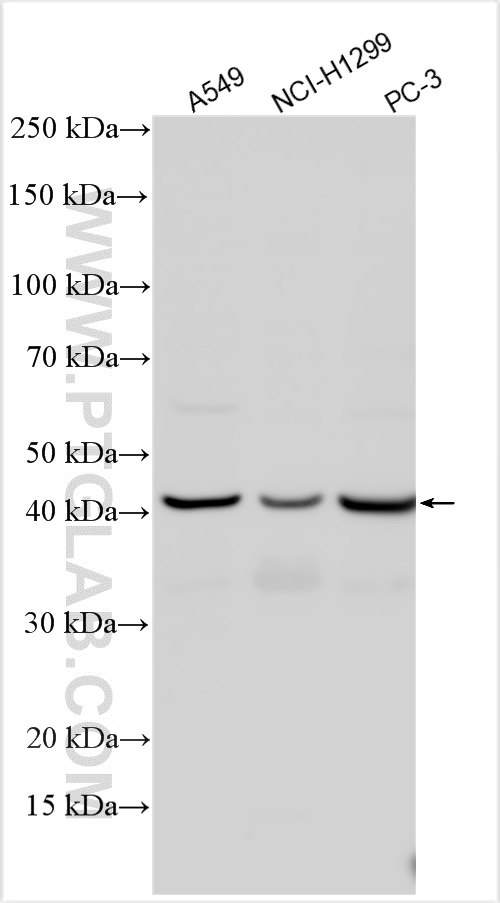验证数据展示
经过测试的应用
| Positive WB detected in | A549 cells, NCI-H1299 cells, PC-3 cells |
推荐稀释比
| 应用 | 推荐稀释比 |
|---|---|
| Western Blot (WB) | WB : 1:2000-1:10000 |
| It is recommended that this reagent should be titrated in each testing system to obtain optimal results. | |
| Sample-dependent, Check data in validation data gallery. | |
产品信息
28594-1-AP targets Siglec-15 in WB, ELISA applications and shows reactivity with Human samples.
| 经测试应用 | WB, ELISA Application Description |
| 经测试反应性 | Human |
| 免疫原 | Siglec-15 fusion protein Ag29829 种属同源性预测 |
| 宿主/亚型 | Rabbit / IgG |
| 抗体类别 | Polyclonal |
| 产品类型 | Antibody |
| 全称 | sialic acid binding Ig-like lectin 15 |
| 别名 | CD33 antigen like 3, CD33L3, HsT1361, SIGLEC 15, SIGLEC15 |
| 计算分子量 | 36 kDa |
| 观测分子量 | 38-40 kDa |
| GenBank蛋白编号 | NM_213602 |
| 基因名称 | Siglec-15 |
| Gene ID (NCBI) | 284266 |
| RRID | AB_2918178 |
| 偶联类型 | Unconjugated |
| 形式 | Liquid |
| 纯化方式 | Antigen affinity purification |
| UNIPROT ID | Q6ZMC9 |
| 储存缓冲液 | PBS with 0.02% sodium azide and 50% glycerol , pH 7.3 |
| 储存条件 | Store at -20°C. Stable for one year after shipment. Aliquoting is unnecessary for -20oC storage. |
背景介绍
Sialic acid binding Ig-like lectin 15 (Siglec-15) is a member of the Siglec family of glycan-recognition proteins. Siglec-15 is a type-I transmembrane protein consisting of two immunoglobulin (Ig)-like domains, a transmembrane domain, and a short cytoplasmic tail (PMID: 17483134). It is mainly expressed on a subset of myeloid lineage cells and can be upregulated in many cancers (PMID: 32939323). Siglec-15 has been reported as a immune suppressor and a potential target for normalization cancer immunotherapy (PMID: 30833750). Siglec-15 has a calculated molecular weight of 36 kDa. It has been detected at 38-40 kDa due to glycosylation (PMID: 32921411).
实验方案
| Product Specific Protocols | |
|---|---|
| WB protocol for Siglec-15 antibody 28594-1-AP | Download protocol |
| Standard Protocols | |
|---|---|
| Click here to view our Standard Protocols |
